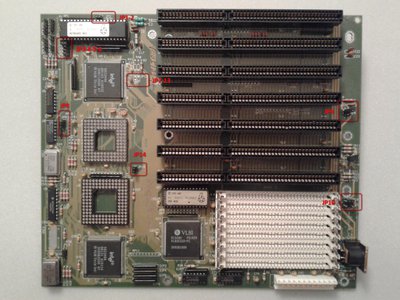First post, by 90sToys
- Rank
- Newbie
Hi everyone,
Another new user and this time he's from Canada! I often look for old hardware info and somehow I always end up reading something from this forum so now that there's something I just can't find I figured that I would just join and ask...BTW the name's Ben.
I'm trying to officially identify the core of my latest project and most specifically obtain a copy of its manual to be sure that I set everything right. I've had it carefully stored for over ten years and I finally decided to build a PC out of it. It's a very intriguing main board and I think that it might be a very early Intel engineered one! I say this because it was made in 1991 by Compeq (not Compaq) http://www.compeq.com.tw/ which is a Taiwanese PCB manufacturer known for having produced main boards for Intel. Also, the main board seem to have an 'AA' number on the backside albeit a strangely formatted one. It also looks like it sports the rare 82340DX 'Topcat' chipset licensed from VLSI. (see attached pictures) Trying to find anything about it is like archaeology so at this point any information on this main board will be welcome!
Thank you
BTW the completed project will hopefully look like this and I'll use it for retro gaming. Any comment on those specs is also welcome! 😀
- Unidentified main board below CHECK!
- Intel i386DX & i387DX @ 33 MHz CHECK!
- 32MB 60ns Interleaved Fast Page Mode w/Parity 30-pin SIMMs (8x 4MB w/9 chips) CHECK!
- ATi Graphics Xpression (Mach64 GX) 4MB DRAM 16-bit ISA Video Card (I know that it's not the best on ISA but I'm going for pure ATi nostalgia so what can you do! Still need to find one though...)
- Adaptec AHA-1542CF 16-bit ISA SCSI-2+Floppy Card CHECK!
- SCSI-2 to Compact Flash Adapter w/2GB Compact Flash Card (Got my eyes on one of the products from http://www.cf2scsi.com/)
- Sound Blaster 16 ASP 16-bit ISA Sound Card CHECK!
- 3Com Etherlink III TP/AUI/BNC 10 Mbps 16-bit ISA Network Card CHECK!
- Multi-I/O 2x 16550 Serial & 1x ECP Parallel 16-bit ISA I/O Card CHECK!
- US Robotics Sportster Voice 56K V.92 8-bit ISA Fax/Modem Card CHECK!
- Plextor PX-40TSI Ultraplex 40MAX 50-pin SCSI CD-ROM Drive CHECK!
- 1.44MB Floppy Drive CHECK!


